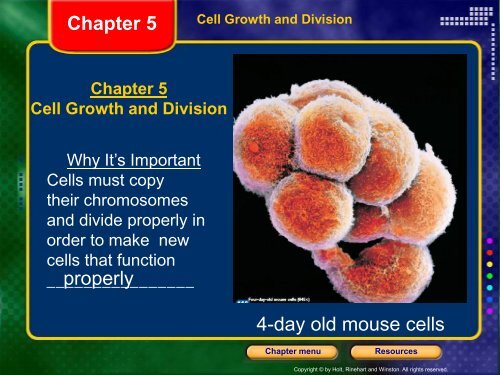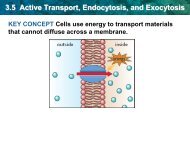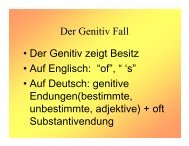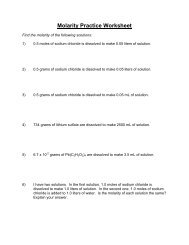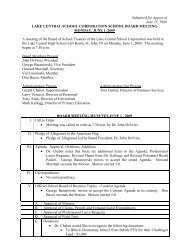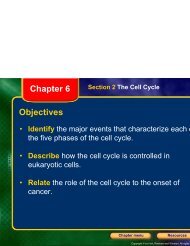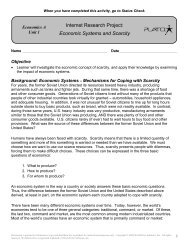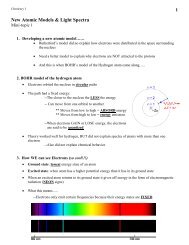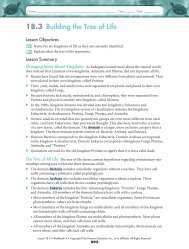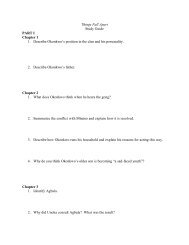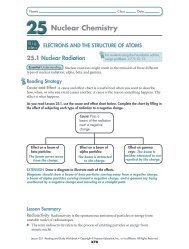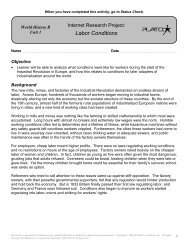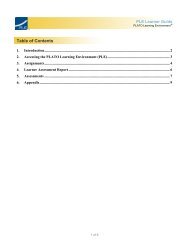Chapter 5.1 Notes
Chapter 5.1 Notes
Chapter 5.1 Notes
Create successful ePaper yourself
Turn your PDF publications into a flip-book with our unique Google optimized e-Paper software.
<strong>Chapter</strong> 5<br />
Cell Growth and Division<br />
<strong>Chapter</strong> 5<br />
Cell Growth and Division<br />
Why It’s Important<br />
Cells must copy<br />
their chromosomes<br />
and divide properly in<br />
order to make new<br />
cells that function<br />
________________<br />
properly<br />
4-day old mouse cells<br />
<strong>Chapter</strong> menu<br />
Resources<br />
Copyright © by Holt, Rinehart and Winston. All rights reserved.
<strong>Chapter</strong> 5<br />
Objectives<br />
• Identify four examples of cell division in eukaryotes<br />
and one example in prokaryotes.<br />
• Differentiate between a gene, a DNA molecule, a<br />
chromosome, and a chromatid.<br />
• Differentiate between homologous chromosomes,<br />
autosomes, and sex chromosomes.<br />
<strong>Chapter</strong> menu<br />
Resources<br />
Copyright © by Holt, Rinehart and Winston. All rights reserved.
<strong>Chapter</strong> 5<br />
Formation of New Cells by Cell Division<br />
reproduction<br />
• Cell division, also called cell _________________,<br />
occurs in humans and other organisms at different<br />
times in their life<br />
repair<br />
________<br />
growth<br />
__________<br />
<strong>Chapter</strong> menu<br />
Resources<br />
Copyright © by Holt, Rinehart and Winston. All rights reserved.
• Before a cell can divide, the DNA must first<br />
be __________ copied and then _______________<br />
distributed<br />
to new cells<br />
• Why does each new cell need an identical<br />
copy of DNA?<br />
DNA codes for the proteins made by<br />
the cell…incorrect DNA will lead to<br />
altered proteins<br />
<strong>Chapter</strong> menu<br />
Resources<br />
Copyright © by Holt, Rinehart and Winston. All rights reserved.
• Prokaryotes carryout a very simple type<br />
of cell division called ______________ binary<br />
___________ fission<br />
– Occurs in two stages:<br />
• 1st DNA is _____________<br />
copied<br />
• 2 nd the original cell divides<br />
into _______ two new cells<br />
<strong>Chapter</strong> menu<br />
Resources<br />
Copyright © by Holt, Rinehart and Winston. All rights reserved.
• The original cell divides by adding<br />
a new cell _____________<br />
membrane<br />
between the copied DNA<br />
• As new material is added, the<br />
membrane _________ pinches in<br />
• Next, a new cell ____________ wall<br />
forms around the membrane<br />
• Last, the original cell pinches off<br />
into two _______________ identical cells<br />
<strong>Chapter</strong> menu<br />
Resources<br />
Copyright © by Holt, Rinehart and Winston. All rights reserved.
• Binary fission is a form of _________________<br />
reproduction because….<br />
single<br />
– It only involves a _____________ parent that<br />
passes ___________ exact copies of its DNA to its<br />
offspring<br />
exact<br />
asexual<br />
– So the offspring are __________ copies of the<br />
parent prokaryotic cell.<br />
<strong>Chapter</strong> menu<br />
Resources<br />
Copyright © by Holt, Rinehart and Winston. All rights reserved.
Eukaryotic Cells<br />
• Before eukaryotic cells divide, their<br />
DNA is ____________ uncoiled and referred<br />
to as _______________<br />
chromatin<br />
double<br />
• Recall that DNA is a _____________<br />
helix made up of subunits called<br />
_________________<br />
nucleotides<br />
<strong>Chapter</strong> menu<br />
Resources<br />
Copyright © by Holt, Rinehart and Winston. All rights reserved.
• Your DNA is normally uncoiled<br />
because the _________ code it contains is<br />
being used to make<br />
_______________<br />
proteins<br />
• Recall that specific segments of your<br />
DNA, called ___________, genes code for<br />
the production of _____________ different<br />
proteins<br />
<strong>Chapter</strong> menu<br />
Resources<br />
Copyright © by Holt, Rinehart and Winston. All rights reserved.
• Before a eukaryotic cell divides, the DNA is<br />
____________, copied and it __________ coils up to form a<br />
chromosome<br />
• First, DNA coils around<br />
histones<br />
proteins called _________<br />
to form small structures<br />
nucleosomes<br />
called ______________<br />
nucleosome<br />
<strong>Chapter</strong> menu<br />
Resources<br />
Copyright © by Holt, Rinehart and Winston. All rights reserved.
• Next, the nucleosomes actually end up coiling<br />
__________ twice on themselves to form a<br />
_________________<br />
supercoil<br />
<strong>Chapter</strong> menu<br />
Resources<br />
Copyright © by Holt, Rinehart and Winston. All rights reserved.
• This supercoil is tightly packed in a structure called a<br />
________________<br />
chromosome<br />
<strong>Chapter</strong> menu<br />
Resources<br />
Copyright © by Holt, Rinehart and Winston. All rights reserved.
• Chromosomes have two<br />
________________ identical sides<br />
because they contain DNA that<br />
has already been ____________ copied<br />
• Each side is called a sister<br />
_____________ chromatid and they are<br />
attached at a point called a<br />
_________________<br />
centromere<br />
<strong>Chapter</strong> menu<br />
Resources<br />
Copyright © by Holt, Rinehart and Winston. All rights reserved.
• These sister chromatids<br />
_______________ separate at the<br />
centromere during cell division to<br />
ensure that each new cell has the<br />
_________ same genetic information as<br />
the original cell<br />
<strong>Chapter</strong> menu<br />
Resources<br />
Copyright © by Holt, Rinehart and Winston. All rights reserved.
<strong>Chapter</strong> 5<br />
Different species<br />
contain different<br />
numbers of<br />
chromosomes<br />
Ex: Humans<br />
have ______ 46<br />
chromosomes<br />
while a dog has<br />
_______ 78<br />
chromosomes<br />
<strong>Chapter</strong> menu<br />
Resources<br />
Copyright © by Holt, Rinehart and Winston. All rights reserved.
Asexual Reproduction – Eukaryotic cells<br />
exact<br />
• Eukaryotic cells will make _________ copies of<br />
themselves during asexual reproduction for four<br />
different types of cell division<br />
– One type is simply for ___________________<br />
– Eukaryotes may also make new cells for<br />
_________________, repair ________________, growth or<br />
_____________________<br />
development<br />
reproduction<br />
<strong>Chapter</strong> menu<br />
Resources<br />
Copyright © by Holt, Rinehart and Winston. All rights reserved.
• Asexual reproduction only occurs in body cells which are<br />
also called ___________________ cells<br />
• Examples of somatic cells are _______________,<br />
_____________, and ________________ cells<br />
muscle<br />
• You want these new cells to do the same job as their<br />
parent cell, so it is good that they make exact<br />
__________of each other<br />
copies<br />
somatic<br />
skin<br />
nerve<br />
• Overtime…the ends of your DNA strands start to<br />
deteriorate so your cells ______ age and change slightly even<br />
though they are “copies”<br />
<strong>Chapter</strong> menu<br />
Resources<br />
Copyright © by Holt, Rinehart and Winston. All rights reserved.
46<br />
• All of your somatic cells contain ____ chromosomes,<br />
which means they are _________ diploid cells<br />
• A diploid cell is mathematically written as ______,<br />
which means they have two _______ sets of<br />
chromosomes…<br />
mother<br />
2n<br />
– you inherit one set from your _____________ and<br />
____________ father<br />
<strong>Chapter</strong> menu<br />
Resources<br />
Copyright © by Holt, Rinehart and Winston. All rights reserved.
Sexual Reproduction – Eukaryotic Cells<br />
One<br />
• ______ pair of your chromosomes are called your<br />
_______ sex chromosomes, because they are involved<br />
with determining your ____________ gender<br />
• Your other 22 pairs of chromosomes are called<br />
________________<br />
autosomes<br />
<strong>Chapter</strong> menu<br />
Resources<br />
Copyright © by Holt, Rinehart and Winston. All rights reserved.
• Your two sex chromosomes are referred to as _____<br />
and _____ Y<br />
– You inherit one from each parent<br />
• ______ XY = male<br />
• ______ = female<br />
XX<br />
• Females can donate only X’s while males can donate<br />
an X or a Y…<br />
• Do males or females determine the sex of an<br />
offspring?<br />
males<br />
X<br />
<strong>Chapter</strong> menu<br />
Resources<br />
Copyright © by Holt, Rinehart and Winston. All rights reserved.
Objective 1<br />
• Identify four examples of cell division in eukaryotes<br />
and one example in prokaryotes.<br />
Binary fission<br />
reproduction<br />
repair<br />
growth<br />
development<br />
<strong>Chapter</strong> menu<br />
Resources<br />
Copyright © by Holt, Rinehart and Winston. All rights reserved.
Objective 2<br />
• Differentiate between a gene, a DNA molecule, a<br />
chromosome, and a chromatid.<br />
Gene – Segment of a DNA that codes for a protein<br />
Chromosome – coiled DNA molecule (x shape<br />
means it has been copied already)<br />
Chromatid – identical copy of DNA found in a<br />
chromosome…held together by<br />
centromeres<br />
<strong>Chapter</strong> menu<br />
Resources<br />
Copyright © by Holt, Rinehart and Winston. All rights reserved.
Objective 3<br />
• Differentiate between homologous chromosomes,<br />
autosomes, and sex chromosomes.<br />
Homologous<br />
(22 Pairs)<br />
Nonhomologous…<br />
determine gender<br />
Similar in<br />
structure<br />
<strong>Chapter</strong> menu<br />
Resources<br />
Copyright © by Holt, Rinehart and Winston. All rights reserved.


